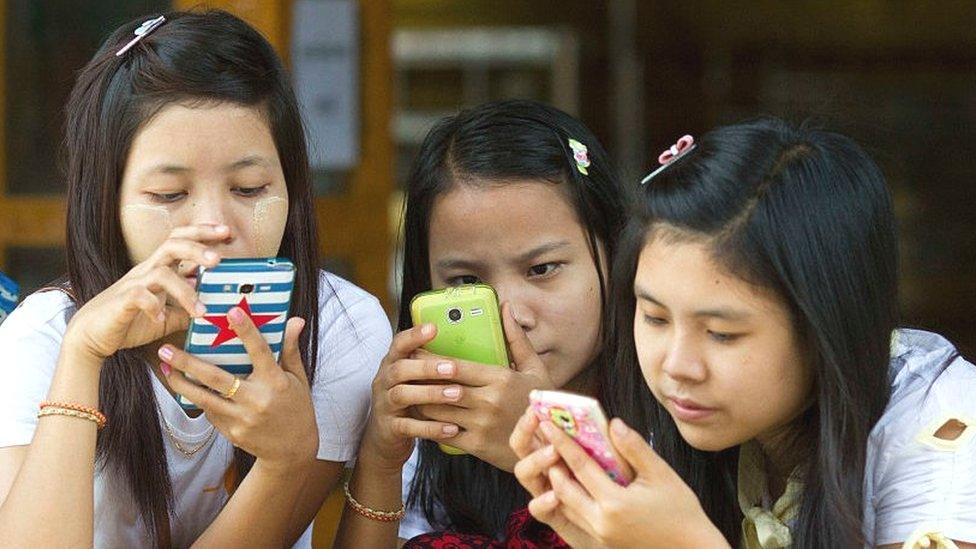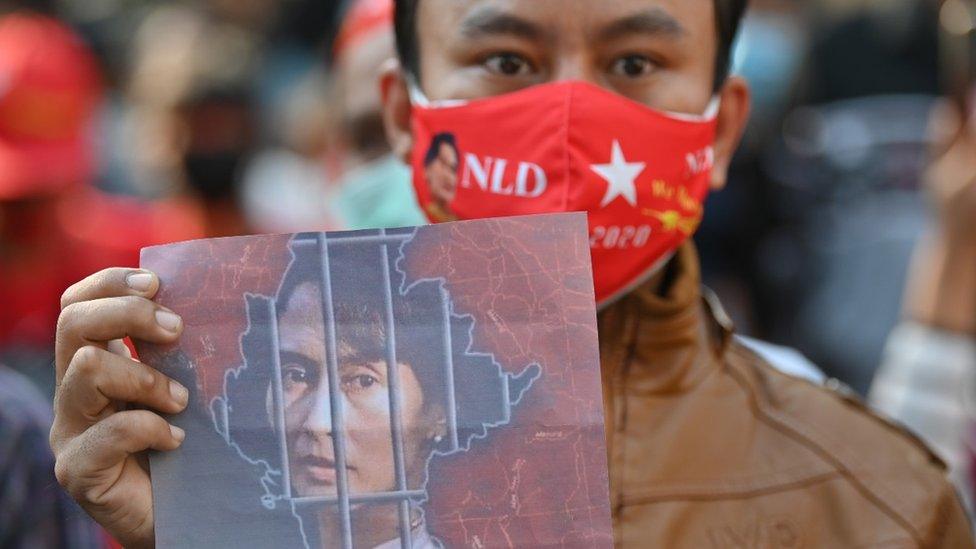Myanmar coup: How the military disrupted the internet
- Published

The military takeover in Myanmar on Monday resulted in internet disruption in large parts of the country.
The authorities have now blocked access to Facebook, which they said was for the sake of "stability".
How the internet dropped off
The restrictions to the internet were reported on Monday at 03:00 local time (20:30 GMT on Sunday).
Internet connectivity had dropped to 50% of normal levels by 08:00 local time that day, as people were waking up to the news of the military takeover.
"Army cut off the state media TV and radios, local phone line and internet getting disabled across the country," tweeted Burmese Reuters journalist Wa Lone.

Facebook is popular in Myanmar, where internet usage has grown in recent years
Data from the internet monitoring service Netblocks shows disruptions on network operators, including state-owned Myanma Posts and Telecommunications (MPT) and an international operator, Telenor.
Netblocks says its findings indicate a "centrally ordered mechanism of disruption... progressing over time as operators comply".
By midday on Monday, internet connectivity had returned to 75% of normal activity.
However, on Wednesday the military blocked access to Facebook, which has been used by activists to co-ordinate opposition to the coup.
For the overwhelming majority in Myanmar, Facebook is the primary means of access to the internet.
Some users are managing to circumvent the ban by using VPNs, which encrypt an internet connection so its location is not identifiable.
Users in the country are rushing to download VPN apps to allow them to do this.
There has been a 4,300% increase in the demand for VPN, according to Top10VPN.com, external, which conducts research on these services.
The authorities have said blocks on Facebook will remain in place until 7 February.
Allow X content?
This article contains content provided by X. We ask for your permission before anything is loaded, as they may be using cookies and other technologies. You may want to read X’s cookie policy, external and privacy policy, external before accepting. To view this content choose ‘accept and continue’.
Regional variations
Some parts of Myanmar, also known as Burma, were more restricted than others.
Based at Monash University in Australia, the IP Observatory, which tracks internet connectivity around the world, found that some regions were severely disrupted.
Magway region was reporting zero internet connectivity at one point.
Yangon region, which includes the country's largest city, dropped in connectivity to about 50% compared to normal times. Restricting internet in the major cities is likely to be more difficult, as users will have access to a wider variety of providers that may implement restrictions at different intensities and at different times.
Most regions are now reporting an increase in internet connectivity.

A protester holding up a poster of detained leader Aung San Suu Kyi
A history of disruption in Myanmar
The Myanmar government has restricted the internet before, especially in areas in Rakhine and Chin states, where the army is fighting local groups. Hundreds of thousands have been displaced by the conflicts.
Article 77 of Myanmar's Telecommunications Law, passed in 2013, is used by the government to cut off telecommunications during a national emergency.
However, human rights groups have called for the law to be amended to protect freedom of expression and have criticised the broad scope of the law.
There were also concerns that health information about Covid-19 was being restricted to some parts of the country, because of an internet shutdown in 2020.
How do governments do it?
A government can disrupt the internet by ordering internet service providers (ISPs) to limit access.
This can include blocking particular sites, such as popular social media platforms. A message such as "server not found" or "this site has been blocked by the network administrator" will show up.
Another method is known as "throttling" - when the bandwidth to a website is limited, making the internet slow and frustrating to use.
Finally, telecoms providers can shut down all access to the internet.
In theory, a telecoms company could challenge a government order. But in countries where the government has a tight grip on the media and can threaten to revoke licences, the willingness to push back on such demands is limited.



Related topics
- Published1 February 2021
